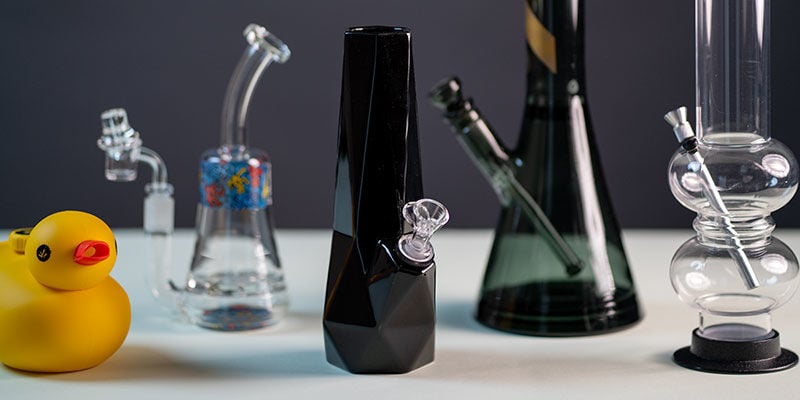
How To Use A Bong
Bongs might look threatening, but they're actually fairly easy to master (if you can get past the coughing). Learn all about how to use a bong here!
Smoking bongs is something most stoners will do at least once in their life. Some people find them to be too much, while others love them.
In this article, we explain a little about these contraptions, teach you how to use them, and finish off with some tips, tricks, and etiquette.
What exactly is a bong?
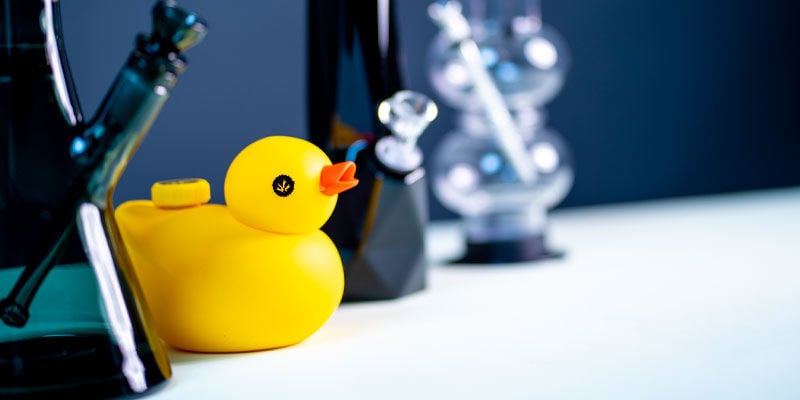
A bong is a device used to smoke weed that filters the smoke through water. This filtration helps to cool it and remove some of the harshness. Bongs are also known as water pipes—as this is essentially what they are.
Similar to bongs are bubblers, which function in almost the same way but don’t have a removable downstem/bowl, which makes the smoking process slightly different. Ultimately though, they fulfil the same function.
Bongs come in all shapes and sizes, can be made of a range of different materials (such as borosilicate glass), and may include many or few extra filtration pieces (such as percolators). As such, bongs can range from very cheap and functional to highly expensive and sporting all manner of bells and whistles—which some stoners will tell you are absolutely necessary.
How does a bong work?
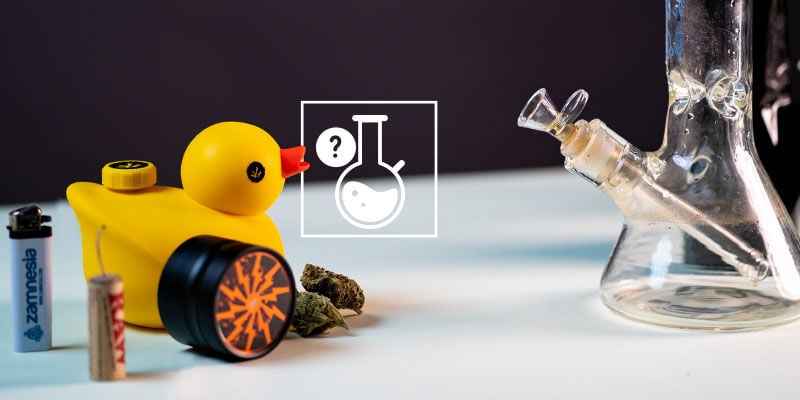
Bongs work very simply. You put your weed in a bowl, hold a flame to it, and breathe through the mouthpiece. As you breathe in, this pulls air through the bong, which draws the flame into the weed in the bowl, burning it. The smoke is then pulled down the downstem, through the water chamber—where it is filtered and cooled—and then up the neck and into your mouth!
In order to draw the smoke from the bong and into your lungs, you need to be able to pull in fresh air. In some bongs, this is achieved with an extra hole (carb hole) on the side, which you cover with a finger while you’re drawing the smoke in, and then release when you want to pull it into your lungs. On other bongs, you can pull the bowl/downstem out to achieve the same thing.
Different parts of a bong
All bongs are born different, but despite this, there are some core features that each will have. These are:
- Water chamber
- Neck
- Mouthpiece
- Downstem
- Bowl
- Base
- Carb hole (optional, but very common)
ANATOMY INFOGRAPHIC
.jpg)
How to use a bong
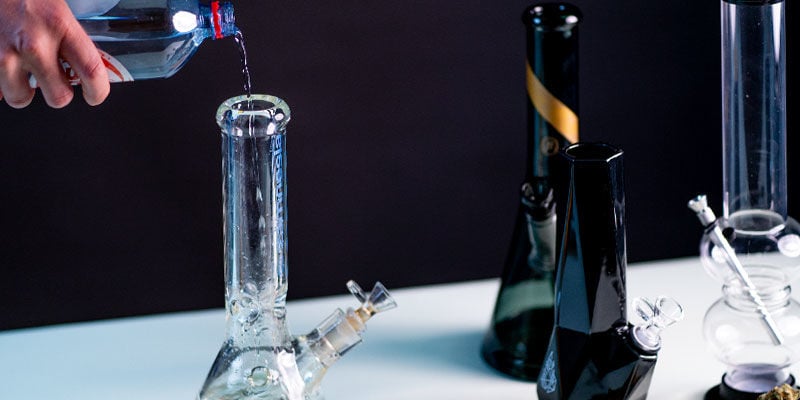
OK, so you've got your bong, laid out your favourite strain, and you're ready for a smoke—but where do you begin? Don't worry; we all had to start somewhere. Whether you're entirely new or reading this section as a bit of a reminder, you'll learn invaluable information on how you can successfully prepare your bong. While it may seem a little daunting initially, our handy steps will lay any doubts or uncertainty to rest.
1. Fill the bong with water
Fill your bong with fresh water before you sit down with it. With most bongs, you pour the water in through the large mouthpiece opening at the top. You want to fill your bong with enough water so that the end of the dowstem is submerged about 2–3cm.
Some elaborate bongs have percolators in the shape of discs, spirals, round domes, etc. inside the chamber or on ancillary parts of the bong. These “percs” can provide extra filtering and cooling for your smoke. Fill these percolators with water as well, and make sure that all air holes are covered—depending on how “fancy” your bong is, you may want to check your bong’s instructions to learn how to fill it properly.
Optional: Fill your bong with ice
If you want, you can add ice cubes to the water. This will cool down the smoke even more so it’s easier on your lungs. Some bongs also have special compartments or notches inside to hold the ice cubes.
2. Grind up your weed
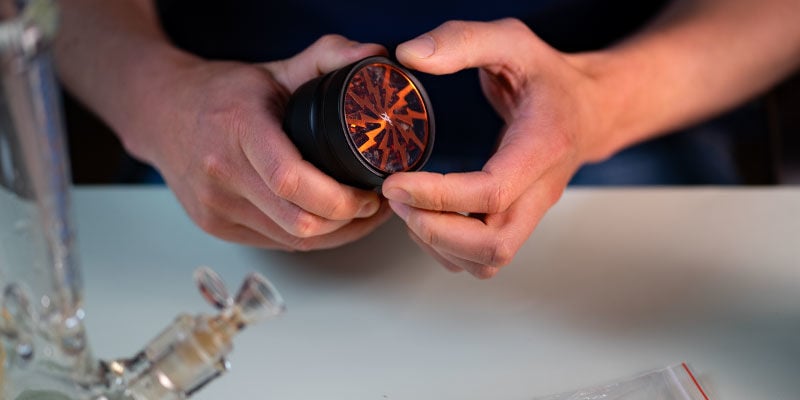
Before you fill your bowl, you need to grind your buds. Take a weed grinder, fill it with a couple buds, and grind them to a medium-fine consistency. If you don’t have a grinder, you can also use your fingers or small scissors, but the result will not be as good.
3. Put a screen in the bowl
Your bowl will very likely need a screen, so make sure that it has one, as this will prevent pieces of your ground bud from falling into the stem. If you’re using a bowl without a screen, it can be good practice to put larger pieces of ground bud at the bottom, just above the hole. This helps to prevent those fine pieces from falling through.
4. Fill the bowl with weed
Take some of your ground weed and loosely pack the bowl. The ideal way to pack is to fill the bowl to near-full capacity, but loose enough that you can comfortably draw in air. If you have to really pull, you’ve packed it too tight.
You will likely want to remove the bowl for packing and then place it into the bong once you’re ready to light up. Some choose to pack with the bowl already attached to the bong—do whatever is easier for you.
5. Take the bong in your hand
Grab the chamber of your bong firmly with your non-dominant hand. Rest the base of the bong on a flat surface if you want a little more support. If you’re more experienced, you can rest the base on your thigh or between your legs if sitting. If you’re brave, you may even hold the bong without support, but you should be particularly careful.
6. Cover the carb hole
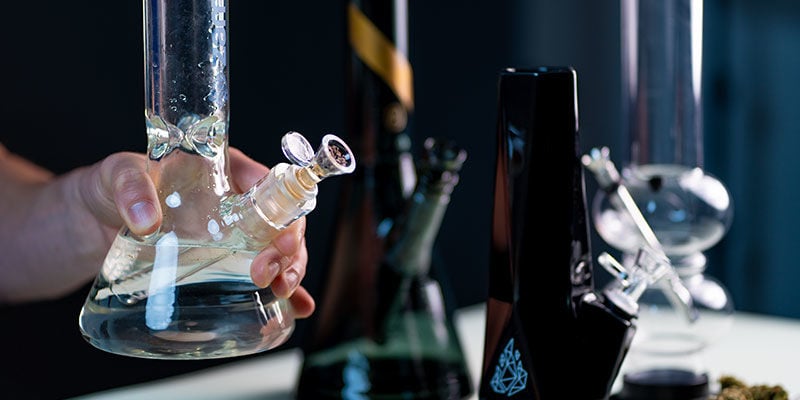
If your bong has a carb hole, cover it with one finger. If you don't, you'll just be sucking air into the bong, not smoke.
7. Put the bong to your mouth and light the bowl
Place your mouth against the mouthpiece of the bong and apply light pressure so it forms a seal. It is best when you pucker your lips a bit, like when kissing. Make sure that the seal remains tight, otherwise it’ll be harder to draw the smoke.
With your free hand, light a match or lighter. Tilt the lighter down near the edge of the bowl and inhale at the same time. As you’re inhaling, this pulls the flame downward and will ignite your weed.
Tip: If you want to reduce the amount of chemicals you're exposed to when smoking cannabis, you can use natural hemp wick instead of a lighter. Use the hemp wick to light your bong, and you won't inhale any unhealthy substances like butane!
8. Remove the flame
You will only need to put the flame to your weed for a second or two as you inhale slowly. Once your weed is lit, remove the flame, but do keep inhaling. Your bowl will stay lit as long as you pull air through it. Keep it cool and relaxed. You don’t need to inhale until you’re out of breath to fill the bong with smoke.
9. Release the carb hole and inhale
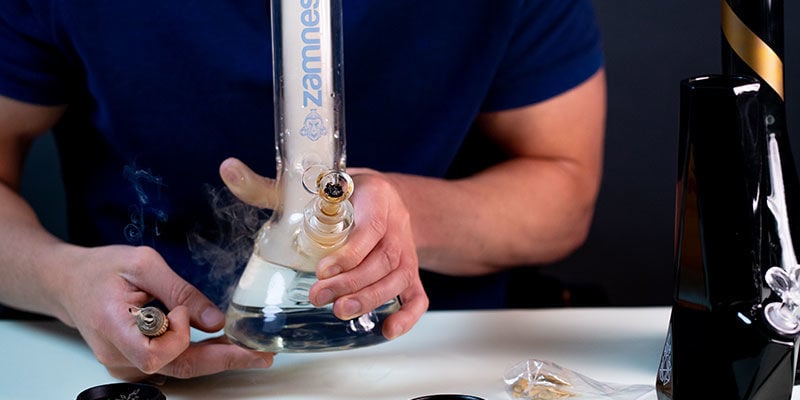
Now, remove your finger from the carb hole. If you have a bong without a carb, you’ll want to remove the bowl so you can inhale the smoke.
10. Exhale without holding
Exhale. You don’t need to hold the smoke in your lungs. Research has shown that the active substances in cannabis are absorbed right away, so there is no benefit to holding the smoke, contrary to what some stoners may tell you.
11. Pass the bong!
Before you pass the bong, you should clear the stale smoke that may be left inside the chamber. You can now pass the bong or put it down on your desk.
The importance of bong etiquette
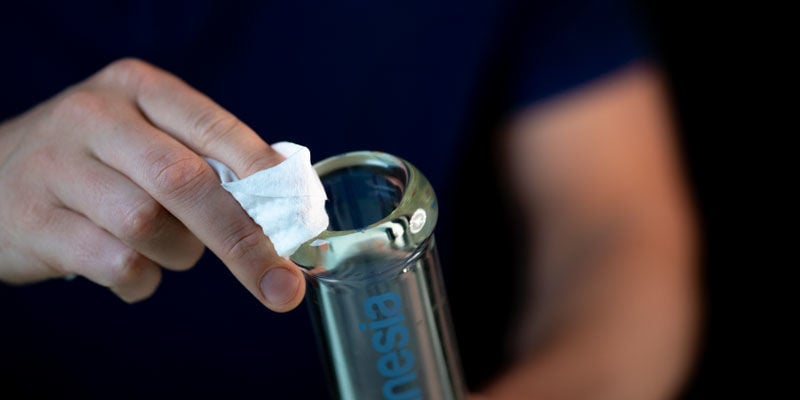
If you’re smoking bongs with friends—and it’s often good fun to do so—there are a few rules of etiquette worth learning:
- Keep things clean: Before you pass the bong to the next person, give the mouthpiece a quick wipe. Nobody wants saliva touching their lips when they go to take their hit.
- Clean the bowl: If you finish the bowl, then you should clean out the ash before passing it to the next person. If you don’t do it, someone has to.
- Don’t burn all the bud: If you’re sharing bowls, then try to light just one side of the bud when you put a flame to the bowl. If you char everything black, you’ll just be passing the next person a burnt-tasting hit.
- Refill the water chamber regularly: If you notice that things are starting to taste pretty gross, then take it upon yourself to empty out the bowl and refill it with fresh water.
Can bongs make you sick?
Dirty bongs really do taste and smell awful. If you keep smoking a dirty bong, especially over multiple sessions, you’ll really be degrading your smoking experience to something quite base.
First, you should replace the water multiple times in a session, if possible. If you can’t be bothered to do this, then at least replace it at the beginning of each new session. From time to time, you should clean everything properly, with warm water and bong cleaner. Use pipe cleaners to scrub those downstems until they’re fresh and shiny!
It’s unusual that a dirty bong will make you ill, but it might make you feel (or even be) sick, as a result of the terrible flavour.
Bong hints and tips
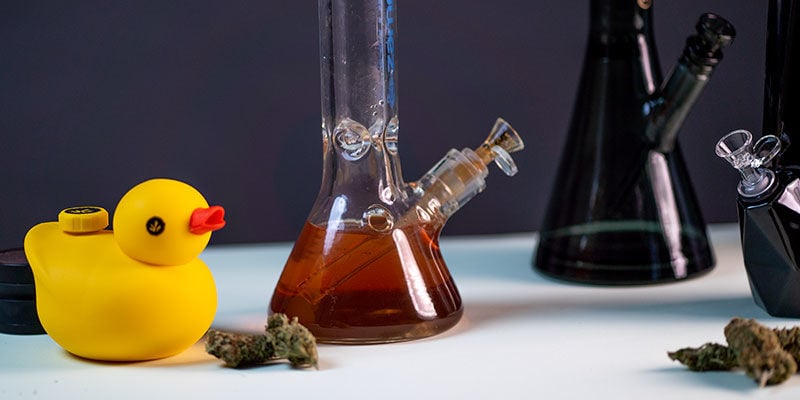
Below, find some top tips for smoking bongs. These will make your life easier, and your smoking more enjoyable.
Replace your bong water often
As mentioned (twice already), replace your bong water regularly. This is by far the easiest way to keep bong smoking fresh rather than disgusting. Plus, the more frequently you change the water, the longer it will take the bong itself to get dirty. A little work now will save you more work in the future!
Take smaller hits
It’s tempting to go all out when smoking bongs, but doing so can quickly cause us to whitey. Don’t be this person.
Take small hits, and you’ll probably have a better time—they’re still strong. Then, if you want more, you can just take another.
Try alternative liquids
While it’s generally agreed that water is the best liquid for bong smoking, some people swear by others. Some like juice, others like sports drinks, and some even go for wine! Experiment, and see what tastes good.
Two things to be aware of, though. Sugary drinks will make your bong dirty much more quickly. Also, bubbly drinks will release gas as you pull the smoke in, which will make it much harder to take a proper hit.
Picking the bong that’s right for you
Bong smoking is fun, but it’s not for everyone. If you just want a mellow little smoke in the evening, then stick to joints and spliffs. Bongs are for getting really high.
If you’re new to bong smoking, and you probably are if you’ve read this far, then start off with a cheap acrylic bong. These can still be very good, but are very cheap and won’t fill you with regret if you decide it’s not for you. Plus, they’re really difficult to break. Have fun!
- Huestis MA, Henningfield JE, & Cone EJ. (1992 Sep-Oct). Blood cannabinoids. I. Absorption of THC and formation of 11-OH-THC and THCCOOH during and after smoking marijuana. - PubMed - NCBI - https://www.ncbi.nlm.nih.gov
-
 3 min
16 January 2024
Does Bong Water Filter Out THC?
Stoners may awake in a cold sweat, wondering if their weed was rendered impotent by the THC-trapping qualities of the bong water. They reach for their bong to quell that fear, but wonder, are you...
3 min
16 January 2024
Does Bong Water Filter Out THC?
Stoners may awake in a cold sweat, wondering if their weed was rendered impotent by the THC-trapping qualities of the bong water. They reach for their bong to quell that fear, but wonder, are you...
-
 5 min
2 December 2021
What Are The Benefits Of Using A Bong?
If you're reading this, you're likely one of the many herb-loving individuals who stands steadfast by their bong. Lucky for you, this smoking method has many benefits, ranging from the functional...
5 min
2 December 2021
What Are The Benefits Of Using A Bong?
If you're reading this, you're likely one of the many herb-loving individuals who stands steadfast by their bong. Lucky for you, this smoking method has many benefits, ranging from the functional...
-
 6 min
21 October 2021
Top 10 Best Glass And Acrylic Bongs
Looking for a good bong? We can help! Here is our list of the 10 best glass bongs and acrylic bongs for every stoner's taste and budget!
6 min
21 October 2021
Top 10 Best Glass And Acrylic Bongs
Looking for a good bong? We can help! Here is our list of the 10 best glass bongs and acrylic bongs for every stoner's taste and budget!
-
 6 min
2 May 2021
What Is An Ice Bong?
In the world of bongs, there is an incredible assortment of high-tech, expensive, and sometimes over-the-top solutions to a simple problem: ripping bongs can hurt! But, as we all know, often the...
6 min
2 May 2021
What Is An Ice Bong?
In the world of bongs, there is an incredible assortment of high-tech, expensive, and sometimes over-the-top solutions to a simple problem: ripping bongs can hurt! But, as we all know, often the...
-
 3 min
23 July 2020
What To Consider When Buying A (First) Bong
Fed up with rolling joints? Not so keen on your vaporizer anymore? Maybe it's time to seek out a bong! But what should you look for when choosing that inaugural bong? Have no fear! This handy guide...
3 min
23 July 2020
What To Consider When Buying A (First) Bong
Fed up with rolling joints? Not so keen on your vaporizer anymore? Maybe it's time to seek out a bong! But what should you look for when choosing that inaugural bong? Have no fear! This handy guide...
-
 2 min
23 November 2015
Top 10 Homemade Bongs and Pipes
Finding new and interesting ways to smoke weed is always fun, so here are to DIY ideas to try for yourself!
2 min
23 November 2015
Top 10 Homemade Bongs and Pipes
Finding new and interesting ways to smoke weed is always fun, so here are to DIY ideas to try for yourself!





 United States
United States

